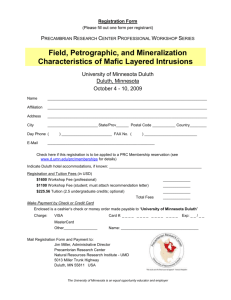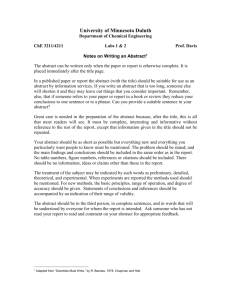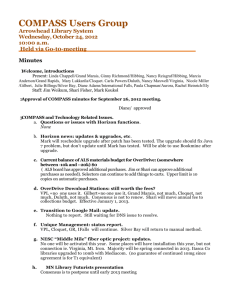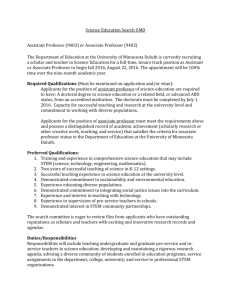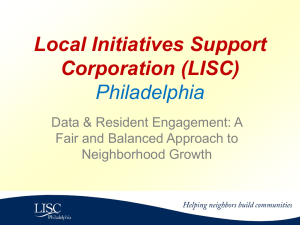East side, west side, all around the town
advertisement
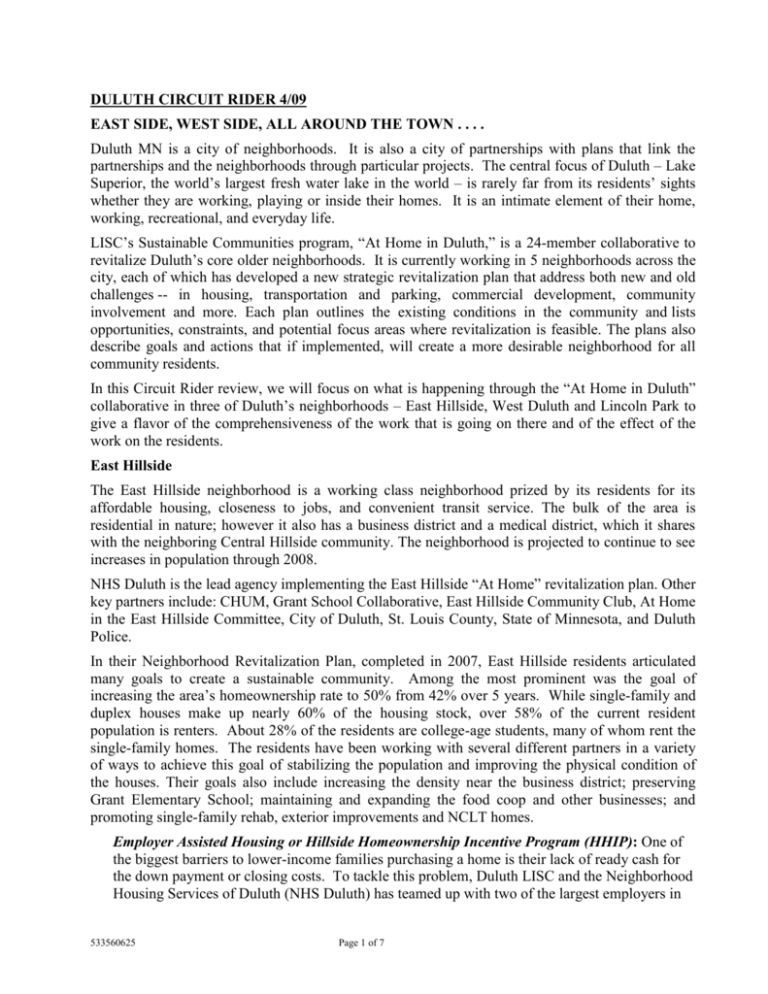
DULUTH CIRCUIT RIDER 4/09 EAST SIDE, WEST SIDE, ALL AROUND THE TOWN . . . . Duluth MN is a city of neighborhoods. It is also a city of partnerships with plans that link the partnerships and the neighborhoods through particular projects. The central focus of Duluth – Lake Superior, the world’s largest fresh water lake in the world – is rarely far from its residents’ sights whether they are working, playing or inside their homes. It is an intimate element of their home, working, recreational, and everyday life. LISC’s Sustainable Communities program, “At Home in Duluth,” is a 24-member collaborative to revitalize Duluth’s core older neighborhoods. It is currently working in 5 neighborhoods across the city, each of which has developed a new strategic revitalization plan that address both new and old challenges -- in housing, transportation and parking, commercial development, community involvement and more. Each plan outlines the existing conditions in the community and lists opportunities, constraints, and potential focus areas where revitalization is feasible. The plans also describe goals and actions that if implemented, will create a more desirable neighborhood for all community residents. In this Circuit Rider review, we will focus on what is happening through the “At Home in Duluth” collaborative in three of Duluth’s neighborhoods – East Hillside, West Duluth and Lincoln Park to give a flavor of the comprehensiveness of the work that is going on there and of the effect of the work on the residents. East Hillside The East Hillside neighborhood is a working class neighborhood prized by its residents for its affordable housing, closeness to jobs, and convenient transit service. The bulk of the area is residential in nature; however it also has a business district and a medical district, which it shares with the neighboring Central Hillside community. The neighborhood is projected to continue to see increases in population through 2008. NHS Duluth is the lead agency implementing the East Hillside “At Home” revitalization plan. Other key partners include: CHUM, Grant School Collaborative, East Hillside Community Club, At Home in the East Hillside Committee, City of Duluth, St. Louis County, State of Minnesota, and Duluth Police. In their Neighborhood Revitalization Plan, completed in 2007, East Hillside residents articulated many goals to create a sustainable community. Among the most prominent was the goal of increasing the area’s homeownership rate to 50% from 42% over 5 years. While single-family and duplex houses make up nearly 60% of the housing stock, over 58% of the current resident population is renters. About 28% of the residents are college-age students, many of whom rent the single-family homes. The residents have been working with several different partners in a variety of ways to achieve this goal of stabilizing the population and improving the physical condition of the houses. Their goals also include increasing the density near the business district; preserving Grant Elementary School; maintaining and expanding the food coop and other businesses; and promoting single-family rehab, exterior improvements and NCLT homes. Employer Assisted Housing or Hillside Homeownership Incentive Program (HHIP): One of the biggest barriers to lower-income families purchasing a home is their lack of ready cash for the down payment or closing costs. To tackle this problem, Duluth LISC and the Neighborhood Housing Services of Duluth (NHS Duluth) has teamed up with two of the largest employers in 533560625 Page 1 of 7 the East Hillside neighborhood (St. Mary’s Duluth Health System and St. Luke’s Hospital) as well as with other local corporations and banks, to create a down payment subsidy program for the hospitals’ employees. Since 2001, NHS has raised over $435,000 to provide recoverable grants of $2,000 to 223 employees to cover down payments and/or closing costs to buy homes in East Hillside and surrounding neighborhoods. LISC continues to contract with NHS Duluth on HHIP, a program that it started and maintains to today. According to George Garnett, Executive Director of NHS Duluth, “It’s a way of encouraging employees to live near where they work and also helps to stabilize the neighborhoods.” The employee works with the private realtors to identify a house and the program places no conditions on the properties that participants can purchase. Garnett went on to say that, “LISC was critical at the beginning and in the lead since they had the relationships and helped design this program that is having a large impact for a small investment. It is an important strategic part of the NHS revitalization tool box that NHS for which found other sources of funding and is looking to expand to other target populations such as African-Americans. Campus Stabilization Program: According to David Peterson of the Housing and Redevelopment Authority of Duluth (Duluth HRA), traditionally stable owner occupied housing in East Hillside has been converted over the years to rental housing for students, primarily of UMD, College of St. Scholastica, Lake Superior College and the University of Wisconsin. In addition to the general lack of upkeep that can occur with absentee-owned rental housing, the presence of a large student population in a low density neighborhood has created conflicts with local homeowners, said Peterson. To reverse this trend, HRA is working on a “three-legged strategy” together with Northern Communities Land Trust (NCLT), the neighborhood residents, and the City. First, they have gotten the City to agree to stop issuing rental licenses in the neighborhood. Second, they are using funds to acquire properties that are on the market and legally licensed for rental so the license would be turned in and there would be one less rental in area; doing minor renovation; and selling to purchasers with covenants to keep the property as owner occupied. HRA has raised $500,000 from LISC for acquisition and development as well as $330,000 from the Greater Minnesota Housing Fund (GMHF) for a rehab/down payment assistance/program that is tied to families with incomes of 80% median or less. Over the last several months, HRA has purchased two houses that meet its criteria. Duluth HRA is working with local contractors, including Duluth’s own Women in Construction Company, and is looking to develop a YouthBuild program so that local contractors can train youth in the trades. Peterson and Rick Ball, the Executive Director of the Duluth HRA, describe their work as we at LISC do, in that they say “We’re flying it as we’re building it.” They are also convinced that other PH agencies around the state and country are facing similar situations and they would like to share their successes with them in the hopes of replicating the program. Other significant activities in East Hillside To create a healthy and inviting living environment, East Hillside partners are working together on a variety of projects. With the support of a LISC Early Action Grant, the At Home in the East Hillside Committee worked with East Hillside PATCH (a grassroots advocacy 533560625 Page 2 of 7 organization), residents and businesses to undertake community building and beautification projects. Over the course of 2008, organizers were able to complete: 1. A major neighborhood recycle/cleanup program after students from two area colleges departed for summer recess in June. 2. An identification program led by NHS to take inventory of vacant, blighted properties; properties were identified by walking the neighborhood, as well as compiling reports from the City and HRA. 3. The creation of a perennial garden overlooking a city-owned creek in the neighborhood. Local college students helped prepare it for planting. A press conference announcing the project’s completion was attended by the mayor and covered by a local TV station. 4. The planting of fifteen replacement trees on 4th Street and 10th Avenue East. In the area of stimulating local economic activity, LISC staff has continued to convene parties interested in redeveloping the vacant National Guard Armory building, located in East Hillside. The “Amory” is located in the Plaza shopping district, which has two small strip malls with a Walgreens, a coffee roasting company, apartment buildings, medical offices, and 1st Lutheran Church. LISC is working with partners to discuss various options for renovation and façade improvements that can be made to the overall shopping district. Local businesses are also participating in the Growing Neighborhood Businesses, a program of the Northeast Entrepreneur Fund, a nonprofit that LISC is funding through its Duluth At Work initiative. West Duluth West Duluth is a community that has seen much change over the past 20 years. Its predominantly blue-collar residents had worked in the iron mills and in transit-related industries. With the closing of the mills and the building of I-35 through the neighborhood, the community faced both opportunities and challenges. While the highway eliminated hundreds of housing units and created yet another physical barrier slicing through the neighborhood, it also created opportunities for new industrial enterprises, eliminated blighted areas, and, probably most important, provided a fast and convenient transportation connection to the rest of the city, region, and state. Led by the Spirit Valley Citizens’ Neighborhood Development Association (SVCNDA), West Duluth developed a plan to “sustain a revitalized” West Duluth, building on the extensive work that the community has already achieved. It includes, among other activities, commercial revitalization work, stabilizing and enhancing the residential areas of the neighborhood, and encouraging a mix of activities, uses and densities. Stimulating Local Economic Activity SVCNDA, starting in 2000, has taken a comprehensive approach to revitalizing the commercial elements of the community. It secured grants of $11,800 from LISC, as well as resources from the City, to develop a West Duluth Business District Plan and a Ramsey Village Plan, followed by a streetscape plan for all of the commercial corridors in the area. It has also participated in the LISC and NHS Duluth “At Home in Duluth” storefront façade renovation program and developed a $400,000 storefront program utilizing TIF funds. According to Kris Ridgewell, Executive Director of SVCNDA, the work that was done under these programs has not only contributed to the upgrading of existing businesses but has also succeeded in attracting new businesses, bringing in over 13 new full-time and part-time employees into the area. 533560625 Page 3 of 7 The façade work has also attracted private funds from developers like WKK who purchased an old restaurant for $275,000, renovated the whole building doing $275,000 worth of work, utilized the storefront programs and then leased the entire building to Focus on Living, an organization with 8 full-time employees that provides services to individuals with mental illness and traumatic brain injury. The work that has been going on around the commercial corridors also was a catalyst for the Police Department to build a new $1.5 million precinct in the neighborhood. It also contributes to the “walkability” and the prevention of crime through environmental design. Crime has gone down 40-42% in the area, which is now sixth in calls to the police for crime, down from second. Expanding Capital Investments: Housing The Veterans Place project, according to Jeff Corey of Northern Communities Land Trust (NCLT), started in 2007 when Duluth’s CD manager approached NCLT to develop a supportive housing multi-family project for the Minnesota Council for Veterans. SVCNDA, the lead organization for the “At Home” West Duluth Plan began working with NCLT to locate a suitable site. They found two dilapidated apartment buildings in the Ramsey Village area of the neighborhood for the project. NCLT is the developer and hopes to continue to own the land in order to preserve long-term affordability (as they do with single family homes). SVCNDA and LISC have worked in Ramsey Village over the past 12 years to develop 54units of affordable and mixed-income housing and welcomed the NCLT project. Not only did SVCNDA assist NCLT to get the project approved by the local planning department but also got a Home Depot grant for the project through LISC $20,000 that will help NCLT do work on a courtyard between the 2 buildings. Corey is very clear that a key element of the project is its centrality, being very much in the heart of the Ramsey neighborhood right across from Ramsey Townhouses built by SVCNDA and NCLT. According to him, “It’s a great place for this project because, frankly, it’s bringing folks close to good things and far away from places they need to be away from. It’s also the best example of a working neighborhood in the city – with the ability to walk to everything you need to be able to get to.” NCLT has received a $75,000 recoverable grant from LISC to help cover predevelopment costs and a $25,000 Home Deport grant brokered by LISC for this project. Housing acquisition rehab/resale project NCLT is also working on dealing with vacant and foreclosed properties in the neighborhood. They have been working on rehabbing properties to meet Minnesota Green Communities criteria and be extremely energy efficient. In West Duluth, NCLT has acquired and rehabbed 5 properties to these standards, including one HUD property, 4 bank foreclosures (2 from estates). They spent differing amounts on the rehabs ranging from a Total Development Cost of $130,000 to about $210,000. According to Sarah Hannigan, director of the program, “For those that are more challenging when acquired, the impact is better seen and, as a result, neighbors come out and are very appreciative.” 533560625 Page 4 of 7 More housing Ramsey Village is “traditional neighborhood” with physical requirements for the housing styles, like a landmark district. It has been a major part of the West Duluth “At Home” plan. Over the past year, SVCNDA in partnership with NCLT and Minnesota Housing Finance Agency and LISC has developed 4 new infill houses for low to mod income families. To reduce sales price, they worked with their partners to get additional $20,000 for down payment assistance to move the sale of one of the houses. They are also working with a private developer to bring in 40 units of senior housing (Phase I) and 20 units of assisted living in Phase II. They partnered with HRA and the City of Duluth to acquire abandoned housing and property around old railroad track area for Phase I and are working with LISC to get predevelopment money. They are looking to start the project in the Fall of 2009. Improving Resident Access to Quality Education What would a neighborhood for families be without access to quality education? SVCNDA is working with the school district on building a new elementary school and expanding the high school in West Duluth. In fact, the owner of a motel that was torn down for Denfeld High School bought a SVCNDA home so they could stay in the neighborhood, according to Kris Ridgewell. They are also advocating locating a community center in the new elementary school. Building Healthy Environments and Lifestyles With LISC, SVCNDA is working on a State Farm grant with kids doing gardens near the new Veterans Place Housing. This is one of many urban gardening projects that students in West Duluth and other parts of the city are Lincoln Park – and “all around the town!” As with East Hillside, Lincoln Park has great views of Lake Superior. Its residential stock consists primarily of single-family homes built in the early 20th century and a lack of housing maintenance and upgrades has resulted in deteriorating homes. It is, however, an area with many amenities such as a park (not surprisingly, Lincoln Park), a golf course, a reservoir and a wilderness area. Area residents are extremely involved in what goes on in the neighborhood whether it is around combating crime by working with the police through the Community Safety Initiative (CSI) program or making sure the city rebuilt the Harrison Recreation & Community Center, after it was nearly destroyed by fire. Not only does the work that goes on in Lincoln Park benefit the residents of the area. It also attracts both money and people from “all around town” as seen in the excitement around the Heritage Sport Center and the entire redevelopment of the former Clyde Iron industrial site. Clyde Park Development One of the neighborhood highlights, identified as a focus in the neighborhood’s 2007 plan, is the redevelopment of the former Clyde Iron industrial site in the lower section of the community. The project, now called Clyde Park, is the outgrowth of the vision of a local developer, Alessandro (Alex) Giuliani, a former accountant and business man. At the time he purchased the initial piece of property for approximately $3.5 million that consisted of the actual iron works building, others also wanted to purchase it and tear it down and build, perhaps, one or more “big box” stores. Giuliani had a different vision -- he wanted to renovate the buildings, 533560625 Page 5 of 7 add to it and make it the center of a place where kids and their families could congregate, where kids could keep active in a safe environment and where he could build this in a green way, without destroying the “heritage” that was there. It would be a place that would celebrate the history and heritage of the place as well as the importance of hockey in Duluth. To Giuliani, the success of the project demonstrates that “where the heart is in the right place and without an agenda, great things can happen.” To date, The Heritage Sports Center has raised over $15 million, including the donation of the building and land by Giuliani valued at $4 million, from a wide range of private and public funders to construct the non-profit elements of the project that include: Heritage Hall, a support facility connected to the arena and pavilion that includes lobby, locker rooms, and concessions, as well as a Boys and Girls Club outreach recreation center in its mezzanine. The hall was built in the existing 18,000-square-foot building that was purchased and donated by Giuliani. Duluth Heritage Sports Center Arena, a year-round hockey facility with 1,200 permanent seats that was constructed from scratch. According to Giuliani and others, the rink is “the finest amateur hockey rink anywhere!” It’s the home rink for all Duluth high schools (for both boys and girls) as well as for the Duluth Amateur Hockey Association. The facility has already established itself as the center for youth hockey for the entire region. It is also available for open skating for the public at scheduled hours. Duluth Heritage Sports Center Pavilion, a multi-purpose recreation center with collapsible seating for 1,000 on the other side of the Heritage Hall that was also constructed from scratch. The Pavilion will serve as a hockey facility from November through March and, with turf received through a $200,000 grant from the LISC NFL program, will be used for a range of field sports during the spring, summer and fall. The Sports Center complex is the cornerstone of the larger Clyde Park Development, which will also include an indoor public market, brewery and hotel. Currently, an $8 million LISC New Markets Tax Credit investment is in the final review and due diligence stages for Clyde Park. Additionally, LISC and the developer are planning to rehabilitate a property adjacent to the Sports Center for the Duluth Children’s Museum in order to relocate it from its current location in Duluth’s downtown Depot Museum. A $21,000 non-housing recoverable grant from Duluth LISC is assisting with this relocation assessment. Harrison Community Center The Lincoln Park community experienced a devastating blow in late 2007 when an existing community center, the Harrison Community Club, was closed due to a fire. Located in a highdensity area, the destruction of the center left residents of all ages without needed services. As with the Heritage Sports Center project, local residents harnessed their energy quickly to raise funds ($20,000) within just three months to pay a portion of the $100,000 insurance deductible that would enable the reconstruction of the Harrison Community Club. The community went to the residents and businesses for donations, hosted a spaghetti dinner, and secured grants from their partners, LISC and NHS, to raise the money they needed. A reopening celebration was held in September 2008, attended by residents, the Mayor and members of City Council. While modest, in the larger scheme of the project, the local donations represented the new found energy in the neighborhood. 533560625 Page 6 of 7 Stimulating Local Economic Activity Both the Lincoln Park residents and the business community know how important it is for potential customers to feel both attracted to stores and to feel safe when looking for a place to shop. That’s why the Storefront Enhancement Program funded by LISC and NHS that provides loans to storeowners to improve the way their businesses look. Stewart’s, a sporting goods/trophy store across from the Heritage site, received a storefront loan of $10,000 and completed their updates including an access ramp for wheelchair accessibility on the first floor. Duluth Grill (formerly Embers) also remodeled their storefront with a, “At Home” Storefront Enhancement loan of $20,000, resulting in a more inviting entrance for its restaurant. Healthy Environments and Life Style: Community Safety As in West Duluth, the residents are concerned about safety and, particularly, in their ability to walk freely in their own community. Residents took action in 2008, through the Lincoln Park Citizens Patrol, which operates biking and walking groups. The group meets twice a month throughout the year and draws an average of 50 participants from around the community. These activities have helped build the momentum of the civic partnership that resulted in a National Night Out block party in August that attracted nearly 200 neighbors and law enforcement personnel. 533560625 Page 7 of 7
